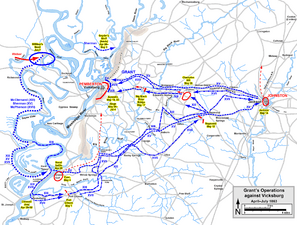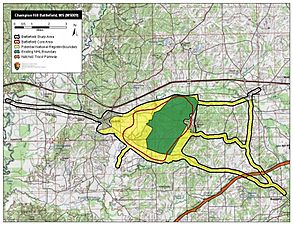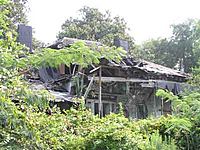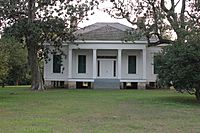Battle of Champion Hill facts for kids
Quick facts for kids Battle of Champion Hill |
|||||||
|---|---|---|---|---|---|---|---|
| Part of the American Civil War | |||||||
 Battle of Champion Hill sketched by Theodore R. Davis |
|||||||
|
|||||||
| Belligerents | |||||||
| Commanders and leaders | |||||||
| Units involved | |||||||
| Army of the Tennessee | Department of Mississippi and East Louisiana | ||||||
| Strength | |||||||
| 32,000 | 22,000 | ||||||
| Casualties and losses | |||||||
| 2,457 total
(410 killed,
1,844 wounded, 187 missing) |
3,840 total
(381 killed,
1,018 wounded, 2,441 missing/captured) |
||||||
The Battle of Champion Hill happened on May 16, 1863. It was a very important battle during the American Civil War (1861–1865). This battle was a key part of the Vicksburg Campaign. Union General Ulysses S. Grant led his Union soldiers against the Confederate States Army led by General John C. Pemberton. Grant's army defeated Pemberton's forces about 20 miles east of Vicksburg, Mississippi. This victory directly led to the Siege of Vicksburg and the surrender of the city. The battle is also sometimes called Baker's Creek.
Contents
What Happened Before the Battle?
After the Union army took control of Jackson, Mississippi, on May 14, both sides made new plans. General Joseph E. Johnston, who was in charge of all Confederate forces in Mississippi, moved most of his army away. He told General John C. Pemberton to leave Edwards Station. Pemberton's army had about 23,000 soldiers. Johnston wanted Pemberton to attack the Union forces near Clinton.
Pemberton and his generals thought Johnston's plan was too risky. Instead, they decided to attack the Union supply wagons. These wagons were moving from Grand Gulf to Raymond. But on May 16, Pemberton got another message from Johnston. It repeated the order to attack at Clinton. Pemberton had already started moving towards the supply trains. His army was on the Raymond-Edwards Road. When he changed his mind and ordered his troops to turn around, his supply wagons ended up at the front of his army.
Who Fought in the Battle?
| Army Commanders at Champion Hill |
|---|
|
The main leaders were General Ulysses S. Grant for the Union and General John C. Pemberton for the Confederates.
Union Forces
The Union army had about 32,000 soldiers ready for this battle.
Confederate Forces
The Confederate army had about 22,000 soldiers.
The Battle Begins
Around 7:00 AM on May 16, Union and Confederate soldiers met. This is when the Battle of Champion Hill started. General Pemberton's Confederate army formed a long defensive line. It stretched for about three miles. Their line was on top of a ridge that looked over Jackson Creek. General Grant later wrote that Pemberton's chosen spot was very good. It was one of the highest points around and gave a good view of the area.
Pemberton didn't know that one Union army group was moving towards his left side. This group was coming along the Jackson Road. It was heading for Champion Hill, which was not well protected. Pemberton had placed General Stephen D. Lee's Alabama soldiers on Champion Hill. They were watching for any Union movement. Soon, Lee's soldiers saw the Union troops, and the Union troops saw them. If the Union forces were not stopped, they would cut off the Confederates. This would block their way back to Vicksburg. Pemberton was told about the Union movement and quickly sent more soldiers to protect his left side. Union forces near the Champion House began to attack, and their cannons started firing.
Union Attack and Confederate Counterattack
When General Grant arrived at Champion Hill around 10:00 AM, he ordered a full attack. General John Alexander McClernand's soldiers attacked on the left side. General James B. McPherson's soldiers attacked on the right. General William Tecumseh Sherman's soldiers were still far behind, coming from Jackson. By 11:30 AM, the Union forces had reached the main Confederate line. At 1:00 PM, they took control of the hill's top. General Carter L. Stevenson's Confederate soldiers retreated in a messy way.
McPherson's soldiers pushed forward. They captured the crossroads, which blocked the Jackson Road escape route for the Confederates. General John S. Bowen's Confederate soldiers then launched a counterattack. They helped Stevenson's retreating soldiers. They pushed the Union forces back past the top of Champion Hill. But they didn't have enough soldiers to hold the position. Pemberton told General William W. Loring to send soldiers from the southern part of the line. These soldiers were not fighting much against McClernand's attack. Pemberton wanted them to help reinforce the hill. However, Loring refused to move. He said there were too many Union soldiers in front of him.
Confederate Retreat
Grant then ordered another attack. He used his soldiers who had just arrived from Clinton. Pemberton's soldiers could not stop this new attack. He ordered his men to use the only escape route left. This was the Raymond Road crossing of Bakers Creek. By this time, Loring had finally decided to obey Pemberton's order. He was marching towards the fighting, but he took a long way around. This kept his soldiers out of the main battle. General Lloyd Tilghman's soldiers formed the rearguard. They fought hard to protect the retreating army. General Tilghman was killed by cannon fire during this stand. Late in the afternoon, Grant's soldiers took control of the Bakers Creek Bridge. By midnight, they had taken Edwards. The Confederate soldiers fell back to a defensive spot at the Big Black River. This was just in front of Vicksburg. The Battle of Big Black River Bridge the next day would be Pemberton's last chance to escape.
What Happened After the Battle?
Champion Hill was a very bloody battle, but it was a clear victory for the Union. In his writings, General Grant said that it's easy to see many enemies fall during a battle. But after the battle, it's sad to see the suffering. He felt it was natural to want to help even the enemy.
Grant was not happy with General McClernand. He felt McClernand did not fight hard enough. Grant believed McClernand could have captured or destroyed Pemberton's entire army. McClernand's soldiers had very few losses on the Union left side. Most of the Union losses, about 2,500, were from McPherson's soldiers on the right. The Confederates lost about 3,800 soldiers. Many Confederate horses were killed. Union soldiers later had to send horses back to get abandoned cannons. The Confederates also lost most of Loring's soldiers. They had marched off on their own to join General Joseph E. Johnston in Jackson.
Preserving the Battlefield
|
Champion Hill Battlefield
|
|
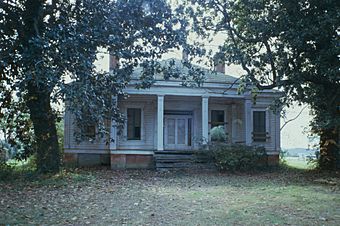
The Coker House, a part of the battlefield
|
|
| Nearest city | Bolton, Mississippi |
|---|---|
| Area | 4,000 acres (1,600 ha) |
| NRHP reference No. | 71000450 |
| Significant dates | |
| Added to NRHP | October 7, 1971 |
| Designated NHLD | May 5, 1977 |
A large area of about 4,000 acres was named the Champion Hill Battlefield in 1971. It was added to the National Register of Historic Places. Later, in 1977, it was also named a National Historic Landmark District. The battlefield is about 3 miles southwest of Bolton, Mississippi.
Many parts of the battlefield are still well preserved today. You can still see the original roads. This is clear when you look at the field from where the old sketches were made. There is a small stone marker at the corner of Billy Fields Road and DJ Johnson Road. This spot is right in the middle of the battlefield.
As of October 2012, some houses had been built on small parts of the field. This was near the center, along DJ Johnson Road. Thousands of acres of the main battlefield are owned by private people. Experts say these areas have a good chance for future preservation. The State of Mississippi owns over 800 acres of the battlefield. These lands might become part of Vicksburg National Military Park one day. The Civil War Trust (now part of the American Battlefield Trust) has helped protect 795 acres of the battlefield. They did this by buying land and setting up special agreements. In 2007, Sid Champion and his family protected 147 acres of their family farm. This was a very important part of the battlefield. By mid-2018, the Trust had preserved 795 acres at Champion Hill. This included a 319-acre piece of land bought for $1.28 million in 2017.
The Coker House is next to the southern part of the Champion Hill battlefield. Union soldiers used it as a hospital during the battle. When they left, they took many things from the house and the farm. You could still see bullet holes in the front door and cannonball holes on the side of the house. In 1985, the historic property was given to a local history group. This group later gave it to the Mississippi Department of Archives and History. By 2005, the house was in ruins. But it has since been rebuilt using as many original materials as possible. It was too damaged to just be repaired. Historical markers at the house tell about the battle and the house's history.
See also
 In Spanish: Batalla de Champion Hill para niños
In Spanish: Batalla de Champion Hill para niños




